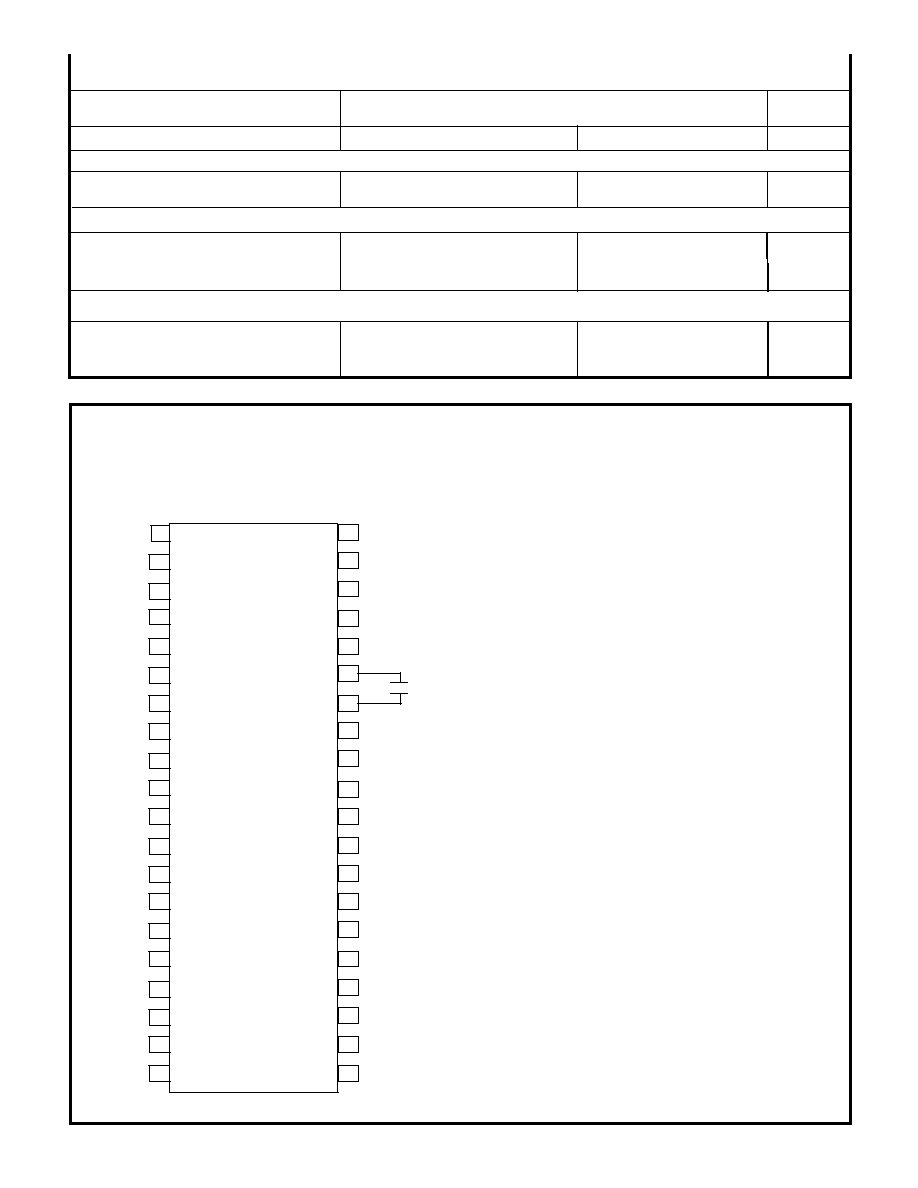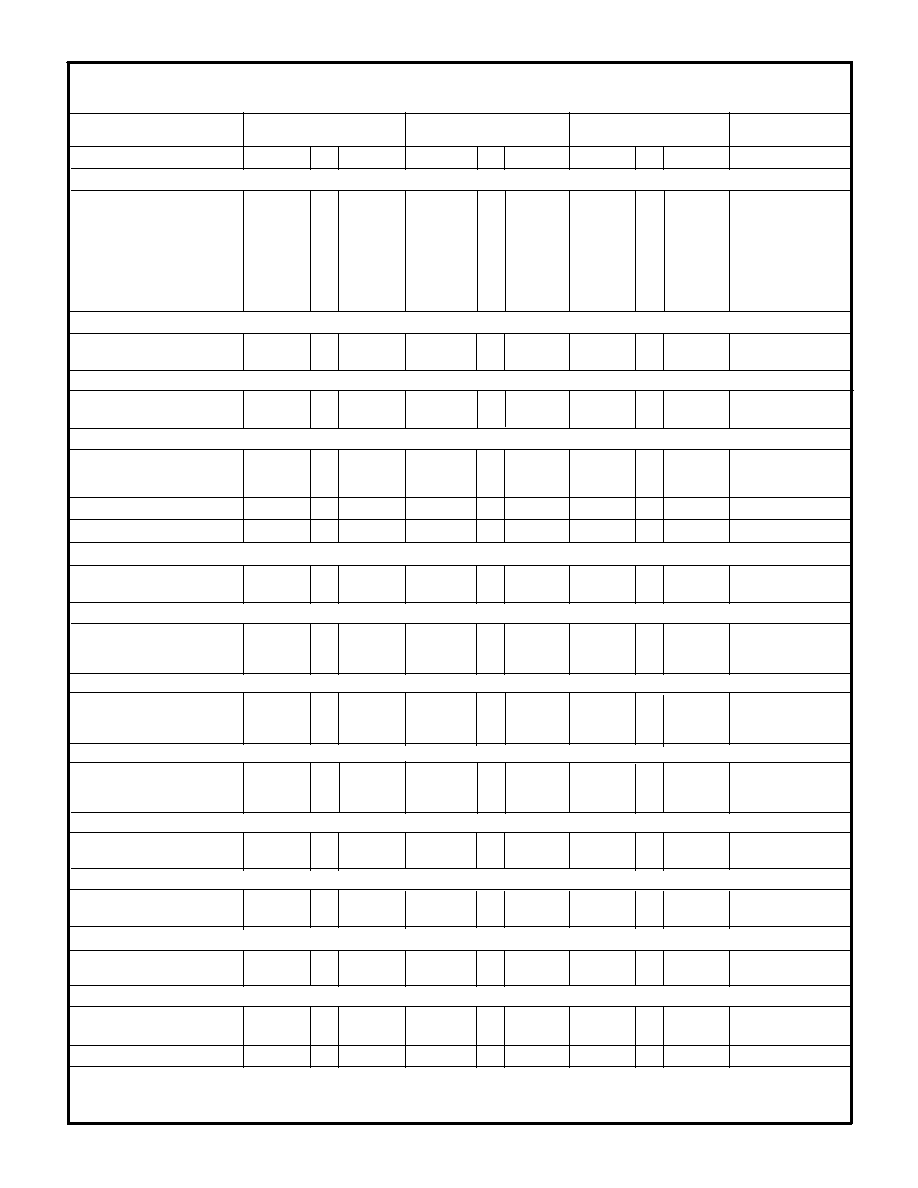 | –≠–ª–µ–∫—Ç—Ä–æ–Ω–Ω—ã–π –∫–æ–º–ø–æ–Ω–µ–Ω—Ç: ADC100CA | –°–∫–∞—á–∞—Ç—å:  PDF PDF  ZIP ZIP |

ADC100
Precision 22 Bit
Integrating A/D Converter
APPLICATIONS
∑ TEST EQUIPMENT
∑ DATA ACQUISITION
∑ SCIENTIFIC INSTRUMENTS
∑ MEDICAL INSTRUMENTS
∑ SEISMOLOGICAL EQUIPMENT
∑ ROBOTIC SYSTEMS
∑ WEIGHING SYSTEMS
FEATURES
ADC100DS REV. E MAR 00
∑ 22-BIT RESOLUTION
∑ ±10.48 INPUT RANGE
∑ 1ppm/∞C MAX. SCALE FACTOR ERROR
∑ 2 ppm MAX. LINEARITY ERROR
∑ AUTO ZERO
∑ BUS COMPATIBLE
∑ INTERNAL CLOCK and REFERENCE
∑ LOW POWER CONSUMPTION (0.4 WATTS)
ADC100C
-25∞C to +85∞C
60ppm
ADC100CA
-25∞C to +85∞C
30ppm
ADC100M
-55∞C to +125∞C
100ppm
Temperature
Max. Scale
Type
Operating Range Factor Deviation
DESCRIPTION
ADC100 is a high performance 22-bit A/D
converter based on a patented architecture
which provides outstanding performance
(accuracy) comparable to the best digital meters.
The ADC100 is available in two operating
temperature ranges, -25∞C to +85∞C and -55∞C
to +125∞C. "M" versions are screened for high
reliability and quality.
ADC100 offers 3 ppm max. linearity error and
1ppm/∞C max. scale factor error over the military
temperature range. It also has excellent offset
stability at 2 ppm max. which the user can auto
zero if desired.
ADC100's compatibility with popular microcomputer buses increases its ease of application in smart
systems. An on-board microprocessor controls all internal functions of the ADC100. Thaler designers
have minimized external connections to greatly reduce the problem often encountered when applying
ADC's.
Operating from ±15VDC and a +5VDC power supply, ADC100 is packaged in a hermetically sealed 40-
pin ceramic DIP package. Precision test equipment, scientific and medical instruments, and data
acquisition systems are primary application areas for the unusually high resolution and accuracy of this
ADC.
THALER CORPORATION ∑ 2015 N. FORBES BOULEVARD ∑ TUCSON, AZ. 85745 ∑ (520) 882-4000

MAXIMUM RATING SPECIFICATIONS
ADC100
MODEL
ADC100
PARAMETER
TEMPERATURE
POWER SUPPLY
INPUTS
MIN
MAX
Operating
Storage
125
160
UNITS
∞C
∞C
Analog Inputs
Digital Inputs
VDC
VDC
VDC
+16
-16
+6
NOTES:
1. Power Supply Decoupling
The ADC100 has internal 0.1µF decoupling
capacitors for all power supply inputs. The
internal decoupling capacitors are adequate
for applications with relatively short power
supply leads (approx. 5") or if additional
capacitors are located on a circuit board.
For applications with long power supply
leads an external capacitor of 10 mF on the
+/- 15V inputs and 33 mF on the +5V input is
recommended.
2. Ground
The ground connection (pin 7) should be
made as solid as possible since ground
noise can result in a loss of accuracy. Use
of a ground plane is a good approach to
maintain the full accuracy of the ADC100.
3. External Components
A 0.68 µF polystyrene integration capacitor
must be connected to pins 34 and 35 with a
lead length not exceeding 2".
4. Analog Inputs
In order to avoid differential noise pickup it is
recommended to use parallel adjacent lines
for the analog inputs (pins 39, 40) on PC
boards and shielded lines outside of the PC
connections.
EXTERNAL CONNECTIONS
V
CC
V
EE
V
DD
V
EE
0
V
CC
V
DD
ADC100DS REV. E MAR 00
+14
-14
+4
-55
0
(TOP VIEW)
ADC100
1
2
3
4
5
6
7
8
9
10
11
12
13
14
15
16
17
18
19
20
40
39
38
37
36
35
34
33
32
31
30
29
28
27
26
25
24
23
22
21
N.C.
N.C.
N.C.
N.C.
N.C.
N.C.
N.C.
N.C.
N.C.
N.C.
N.C.
N.C.
N.C.
N.C.
D0
D1
D2
D5
D4
D3
D6
D7
GND
ANALOG LOW
ANALOG HIGH
AUTO ZERO
RESET
STATUS 1
STATUS 0
CONVERT
OUTPUT ENABLE
Vee (-15V)
Vee (+15V)
Vdd (+5V)
INTEGRATION
CAPACITOR
N.C.
N.C.
N.C.
N.C.
N.C.

ELECTRICAL SPECIFICATIONS
MODEL
PARAMETER
ACCURACY
TEMPERATURE STABILITY
TIME STABILITY
ERROR ALL SOURCES
CONVERSION TIME
WARM-UP TIME
TEMPERATURE RANGE
CONVERT INPUT
AUTO ZERO INPUT
DIGITAL OUTPUTS
DIGITAL INPUTS
POWER SUPPLY CURRENTS
POWER SUPPLY VOLTAGES
ANALOG INPUT CHARACTERISTICS
POWER SUPPLY REJECTION
Resolution
Input Equivalent Noise
Offset without Auto Zero
Offset with Auto Zero
Full Scale
Noise (.1-10Hz) @ 10V
Nonlinearity
Normal Mode Rejection
Offset
Full Scale
Offset
Full Scale
MIN
MAX
TYP
MIN
MAX
TYP
MIN
MAX
TYP
ADC100C
ADC100CA
ADC100M
Bits
µV
ppm
ppm
ppm
µVpp
ppm
dB
22
1
6
*
*
*
*
*
*
*
*
*
*
60
*
*
0.2
0.1
*
1.0
0.5
*
ppm/
o
C
ppm/
o
C
.1
2
ppm/24 hrs.
ppm/month
.0007, 2
.0005, 2
%, +/- Counts
24 hrs, +/- 1 Deg. C Amb.
90 days, +/- 5 Deg. C Amb.
1 year, +/- 5 Deg. C Amb.
.0010, 2
.0008, 2
*
.0015, 2
.0013, 2
%, +/- Counts
%, +/- Counts
*
*
320
ms
*
5
*
*
*
minutes
+/- 15 VDC
5 VDC
80
80
*
*
dB
*
*
dB
Low
High
Low
High
Low
High
Low
High
-25
85
*
*
-55
125
V
V
V
V
V
V
V
V
0.8
*
4.0
*
0.8
*
*
4.0
*
*
4.0
*
*
4.0
*
*
*
*
0.8
*
*
0.8
*
*
+15 V
23
*
*
mA
-15 V
24
*
*
mA
5 v
42
*
*
mA
+15 V
-15 V
5 v
14.5
15
15.5
*
*
*
*
*
*
V
14.5
15
15.5
*
*
*
*
*
*
V
4.5
5
5.5
*
*
*
*
*
*
V
Input Range
-10.485760
10.485755
3
*
*
*
*
V
Bias Current
1.2
*
*
nA
Input Impedance
200
*
*
G
2
0.5
50
2
* Same as ADC100C
Note: 1) 60 Cycle
2) ( Max-Min Value) - Noise(.1-10Hz)
ADC100
(Vps = +/- 15V, + 5V, T = 25 Deg. C.)
*
*
*
*
4
1
100
3
1
o
C
2
ADC100DS REV. E MAR 00

THEORY OF OPERATION
The timing control circuitry governs the counters that
measure the integration time in both directions.
The ADC100's on-board microprocessor is used to
calculate the results of the integration equation above.
It is also used to perform error corrections and to
control the built-in-auto-zero function. Note that the
mP automatically performs an auto-zero function at
start-up, but it is recommended, to achieve maximum
accuracy, that an auto-zero be performed again after
the ADC100 is fully warmed up.
When the µP detects a convert signal, it lowers the
status lines to indicate that the ADC is involved in a
conversion. When it detects a change in slope
direction, the µP will collect the counts for the
integration time. When sufficient counts have been
collected, the µP performs the calculations described
above.
When the calculations are complete, the µmP places
the most significant byte in the output buffer and
raises the S
0
flag. When another pulse is placed on
the convert line, the middle byte is placed on the
output, the S
0
flag is lowered and the S
1
flag raised.
When the last pulse is placed in the convert line, the
least significant byte is placed in the output buffer and
both status flags are high indicating that the ADC100
is ready for another conversion.
Status line summary:
FIGURE 1. BLOCK DIAGRAM
Conversion in progress.
Conversion complete. MSB in output.
Middle byte in output register.
LSB in output. Ready for next conversion.
0 0
0 1
1 0
1 1
S
1
S
0
In the ADC100 block diagram (see Figure 1), V
hi
and V
low
are the inputs. Both are buffered and fed
into a differential, voltage controlled, single output
current source. This current is added to the
reference current at the input of the op amp
integrator. The output of the integrator is fed into
a Schmitt trigger, which in turn, is fed into the
ADC's timing control circuitry. When the
integrator output actuates the Schmitt trigger, the
timing circuit changes the direction of the
reference current source and the integrator
begins integrating in the opposite direction. This
continues until the Schmitt trigger is actuated
again by the integrator and reverses the direction
of the reference current.
The equation for integration times are:
T
p
=
V X C
I
ref
+ I
inp
T
m
=
V X C
-I
ref
+ I
inp
Resolving these equations produces:
I
inp
= I
ref
T
p
- T
m
T
p
+ T
m
V = Voltage
C= Integration Capacitor Value
I
ref =
Reference Current
I
inp =
Input Current
T
p =
Time Positive
T
m =
Time Negative
ADC100DS REV. E MAR 00
Auto
Zero
Switch
Schmitt
Trigger
Bidirectional
Reference
Current Source
Current
Directional
Switch
Timing
Control
and
Counter
Microprocessor
Output
Buffer
Clock
Differential
Voltage Controlled
Current Source
V
hi
V
low
+15V
-15V
Auto
Zero
Convert
Status
Lines
Output Enable
Data
Output
Ô
Ô
Ô

CONNECTING THE ADC100
POWER SUPPLIES
The power supply lines are connected to pins 4-7.
Pin 4 is -15V, pin 5 is +15v, pin 6 is +5V and pin 7 is
GND.
OUTPUT DATA LINES
The output data is available in byte form on pins
13-20. Pin 20 is the Most Significant Bit and pin 13
the Least Significant Bit. The data lines go to a high
impedance state when the Output Enable line is at a
logic one level.
OUTPUT ENABLE (PIN 21)
Data is placed on the Output Data Lines by a logic
zero on this line.
CONVERT (Pin22)
This line is used to initiate a conversion cycle and
to retrieve the output data. The status lines indicate
which function will be executed. The first pulse
(transition from logic one to logic zero) starts the
conversion cycle. Two subsequent pulses are used
to place the lower two bytes on the Output Data
Lines.
Conversion in progress.
Conversion complete. MSB in output.
Middle byte in output register.
LSB in output. Ready for next conversion.
0 0
0 1
1 0
1 1
S
1
S
0
AUTO-ZERO / RESET (Pin 29)
A logic zero on this input will autozero the ADC150-
3 by internally connecting the analog high to analog
low. Since the µP is reset the status lines S1 and
S0 are tristate before going to the low position. The
status lines will remain low until the autozero is
complete.
INTEGRATION CAPACITOR (Pin 34, 35)
A .68 µF polystyrene capacitor must be connected
to these pins. Lead length should be as short as
possible and not exceed 2".
ANALOG INPUTS (Pin 39, 40)
Both analog inputs are buffered by op-amps and
have a common mode rejection of approximately
80dB. min. To maintain the full accuracy at the
ADC it is recommended to keep the input to analog
common to less than 0.1VDC.
OUTPUT DATA REPRESENTATION
The output data is represented in BOB (Bipolar Offset Binary)
format. One LSB is scaled to be exactly 5mV. The table below
shows the output data codes for zero and plus-minus full scale
input voltage.
Input Voltage
Output Data
High Byte
Middle Byte Low Byte
00
20
3F
00
00
FF
00
00
FF
-10.485760 V
0.0 V
+10.485755 V
STATUS LINES (Pins 23, 24)
These lines indicate the present state of the ADC. When the Convert line receives the first pulse in a
conversion cycle the Status Lines go to logic zero, indicating that a conversion cycle is in progress. When
the conversion is complete the microprocessor places the MSB of the output data in the output buffer and
then raises S
0
to a logic one, indicating that the MSB at the output data is available in the output buffer.
When the Convert Line is pulsed again the middle byte of the output data is placed in that output buffer and
S
1
changes to logic one and S
0
to logic zero. The third pulse places the LSB of the output data in the buffer
and both status lines go to the logic one. The converter is now ready for the next conversion cycle.
The table below shows a summary of the status code.
ADC100DS REV. E MAR 00




